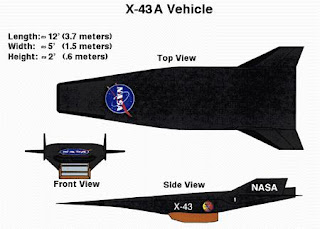 Three views diagram of X-43A Hyperplane
Three views diagram of X-43A HyperplaneIt will be the first time that a non-rocket propelled; air-breathing engine has powered a vehicle in flight at hypersonic speeds, or more than five times the speed of sound. An aircraft moving at Mach 5 would travel about one mile per second or about 3,600 mph at sea level, far faster than any air-breathing aircraft has ever flown.
Unlike a rocket that carries its own oxygen for combustion, the X-43A's scramjet-short for supersonic-combustion ramjet-scoops air from the atmosphere, making the aircraft lighter, which enables it to carry heavier payloads. The hydrogen-fueled aircraft has a wingspan of approximately five feet, measures 12 feet long and weighs about 2,800 pounds. The first unpiloted X-43A and its Pegasus booster rocket will be air-launched from a B-52 from NASA's Dryden Flight Research Center at Edwards, Calif. The booster will accelerate the X-43A to Mach 7 at approximately 95,000 feet. At booster burnout, the X-43 will separate from the booster and fly under its own power on a pre-programmed flight path. The NASA Hyper-X Program's development and flight testing of the X-43 vehicle is conducted jointly by Dryden and the Langley Research Center, Hampton, Va.
"The Hyper-X Program and the X-43A Flight Project have forged a very fruitful partnership and national asset," said Joel Sitz, Dryden's X-43 project manager. "What the country is witnessing is the re-birth of hypersonics. "After a successful X-43A mission, the 'brain trust' will exist to move forward with future propulsion- research vehicles that will ultimately result in more efficient space access vehicles," Sitz added.
"The Hyper-X program takes what we've been doing for the last 40 years in wind tunnel research to flight. Flight is reality," said Vince Rausch, Hyper-X program manager at Langley. "The program is structured around the scramjet engine and should be a major leap forward in the national capability for access to space. The country is looking for safer, more flexible, less expensive ways to get to space, and that's what the scramjet engine would bring us."
Scramjet technology could also allow more traditional aircraft-like operations of launch vehicles, with horizontal take-off, landing and servicing, which could greatly reduce operational cost and time between flights. Three X-43A flights are planned; the first two will fly at Mach 7 and the third at Mach 10. Valuable performance data will be relayed electronically to Dryden and Langley. Each experimental aircraft will fly once in the Naval Air Warfare Center Weapons Division Sea Range off the southern coast of California and impact into the Pacific Ocean.
Like the comparatively slower ramjet counterpart, the scramjet has a simple mechanical design with no moving parts. However, scramjet combustion occurs at supersonic air speeds in the engine. Rather than using a rotating compressor like a turbojet engine, the forward velocity and vehicle aerodynamic design compress air into the engine. There, fuel, usually hydrogen, is injected and the expanding hot gases from combustion accelerate the exhaust air and create thrust. In the case of X-43, the thrust will propel the vehicle at hypersonic speeds up to Mach 10. The first free-flight test will be approximately three weeks after an upcoming captive-carry flight, where the B-52 flies with the X-43A "stack" to the test range for a series of flight systems tests. Following the first series of X-43A hypersonic flights, the next step is an expanded hypersonics research ground and flight program currently in place as part of the Advanced Space Transportation Program, which is led by the Marshall Space Flight Center in Huntsville, Ala.




No comments:
Post a Comment